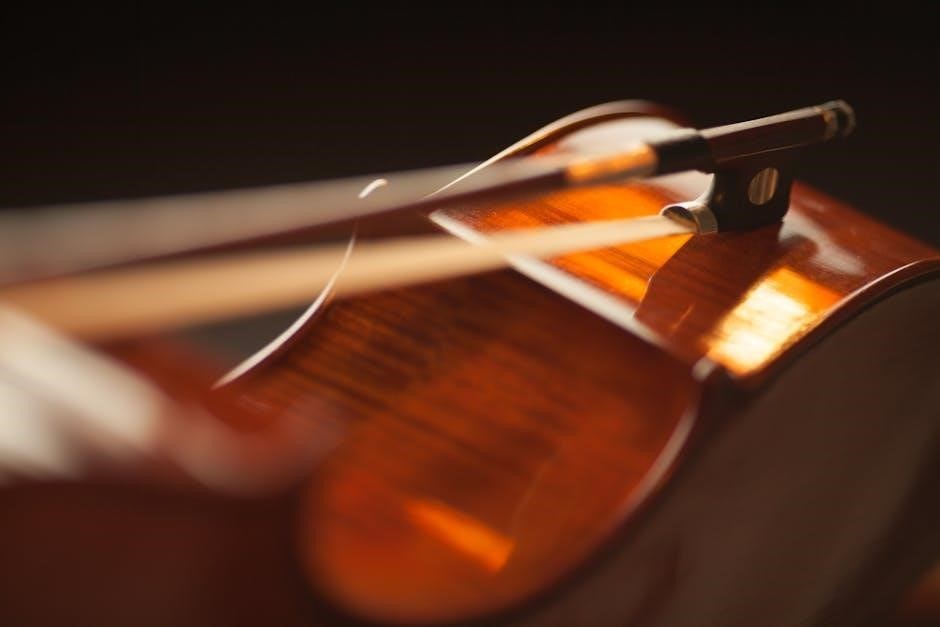
barber adagio for strings pdf
Samuel Barber’s Adagio for Strings, Op․ 11, is a timeless orchestral masterpiece, originally part of a string quartet․ Its haunting beauty and emotional depth have made it iconic, widely used in films and performances․ Available as a PDF, it remains a cornerstone of classical music, showcasing Barber’s genius in evoking profound sentiment through melody and harmony․
1․1 Historical Context and Significance
Composed in 1936, Samuel Barber’s Adagio for Strings was originally the slow movement of his String Quartet, Op․ 11․ It gained fame after being arranged for full string orchestra, becoming a landmark of modern classical music․ The piece is known for its hauntingly beautiful, emotive qualities, resonating deeply with listeners․ Its historical significance grew during World War II, as it became a symbol of comfort and reflection․ Dedicated to Barber’s aunt and uncle, Louise and Sidney Homer, the work remains a timeless expression of sorrow and elegance, widely used in films and memorials․ Its PDF version is sought after by musicians and educators worldwide for its cultural and educational value․
1․2 Popularity and Cultural Impact
Samuel Barber’s Adagio for Strings has transcended classical music boundaries, becoming a cultural phenomenon․ Its emotional depth and haunting beauty have made it a favorite in film soundtracks, such as in Platoon, and during moments of public mourning, like Princess Diana’s funeral․ The piece’s universal appeal lies in its ability to evoke profound emotions, making it accessible to diverse audiences․ Its widespread use in media and its presence in popular culture have cemented its status as one of the most recognizable and cherished compositions of the 20th century․

Composition and Structure
Barber’s Adagio for Strings was originally the slow movement of his String Quartet, Op․ 11, later arranged for string orchestra․ It is written in B-flat minor, marked Molto adagio, featuring a haunting, emotive melody that builds to a climax before gently resolving, showcasing Barber’s mastery of harmonic and structural simplicity․

2․1 Original String Quartet Version
Samuel Barber’s Adagio for Strings was initially composed in 1936 as the second movement of his String Quartet, Op․ 11․ The piece was later transcribed for string orchestra by the composer himself․ The original quartet version features a hauntingly beautiful melody, showcasing Barber’s ability to evoke deep emotion through simplicity․ The music is marked Molto adagio, with a cantabile style that emphasizes lyrical expression․ This version remains a testament to Barber’s mastery of chamber music, offering a more intimate interpretation of the iconic theme․ PDF versions of the original score are widely available for study and performance․
2․2 Arrangement for String Orchestra
Barber transcribed his String Quartet’s second movement for string orchestra in 1940, expanding its emotional resonance․ The arrangement enhances the original’s intimacy with layered dynamics, creating a richer, more expansive sound․ It retains the Molto adagio tempo and expressive cantabile style, while amplifying the ensemble’s harmonic depth․ This version, dedicated to Barber’s aunt and uncle, Louise and Sidney Homer, has become iconic in classical music; PDF scores of the orchestral arrangement are widely available, offering musicians and conductors detailed parts for performance and study․
2․3 Dedication to Louise and Sidney Homer
Samuel Barber dedicated the arrangement of Adagio for Strings to his aunt, Louise Homer, and her husband, Sidney․ Louise, a renowned contralto, was a significant figure in Barber’s early musical development․ The dedication reflects the deep emotional connection Barber felt towards his aunt, who supported his compositional career․ This personal touch adds a layer of sentimentality to the piece, making it more than just a musical work—it is a testament to the enduring impact of personal relationships on artistry․ The dedication is noted in many PDF versions of the score, preserving this meaningful detail for future generations․

Sheet Music and Scores

Samuel Barber’s Adagio for Strings is widely available as PDF sheet music for various instruments and arrangements․ Reliable sources like G․ Schirmer, Inc․, offer authentic scores, ensuring copyright compliance and high-quality notation for musicians and educators․
3․1 Availability of PDF Versions
PDF versions of Samuel Barber’s Adagio for Strings are widely available online, offering convenience for musicians and educators․ Websites like G․ Schirmer, Inc․, and The Sheet Music Library provide authentic scores, with both free and paid options․ Free versions are accessible through platforms like MuseScore, while paid editions ensure high-quality notation; Additionally, transcriptions for piano, guitar, and other instruments are downloadable in PDF format․ These digital resources enable easy access to Barber’s masterpiece, supporting performance and study worldwide․
3․2 Transcriptions for Different Instruments
Transcriptions of Samuel Barber’s Adagio for Strings are available for various instruments, expanding its accessibility․ Piano, guitar, and flute arrangements are particularly popular, offering new interpretations․ These transcriptions maintain the piece’s emotional core while adapting to different instrumental timbres․ PDF and MIDI files of these arrangements can be downloaded from platforms like MuseScore and Sheet Music Direct, enabling musicians to explore Barber’s masterpiece in diverse musical settings․ This versatility has helped keep the work relevant across genres and performances․
3․3 Publisher Information and Copyright Details
The Adagio for Strings is published by G․ Schirmer, Inc․, with copyright details dating back to 1939 and renewed in 1966․ The score and parts are distributed exclusively by Schirmer, ensuring authenticity․ Users are advised to respect copyright laws when accessing or sharing the PDF, as unauthorized distribution is prohibited․ Legal access is available through reputable platforms like JW Pepper and Sheet Music Direct, which offer licensed versions of the work․ Always verify publisher information to ensure compliance with copyright regulations․

Performance and Interpretation
Conductors like Leonard Bernstein have famously interpreted Adagio for Strings, emphasizing its emotional depth and nuanced phrasing․ Performances often highlight the piece’s swelling dynamics and heartfelt melodies․
4․1 Conductors’ Approaches to the Piece
Leonard Bernstein’s interpretation of Adagio for Strings is renowned for its emotional intensity, emphasizing the piece’s swelling dynamics and poignant phrasing․ Conductors often highlight the work’s expressive nuances, maintaining a tempo that allows the music to breathe naturally․ The score, marked by Barber as “molto adagio espressivo,” guides conductors to evoke a sense of longing and nostalgia․ Many interpretations focus on balancing the interplay between strings, creating a cohesive and deeply moving performance that resonates with audiences worldwide․
4․2 Famous Recordings and Performances
Leonard Bernstein’s recording with the New York Philharmonic is iconic, capturing the piece’s emotional depth․ The London Symphony Orchestra’s rendition, led by conductor André Previn, is also celebrated for its haunting beauty․ Adagio for Strings was famously performed during the funeral of President John F․ Kennedy, further cementing its cultural significance; Many orchestras worldwide have recorded it, each interpreting the score’s poignant nuances․ These performances highlight the work’s universal appeal and its ability to evoke profound emotion, making it a timeless classic in classical music․
4․3 Use in Film and Media
Samuel Barber’s Adagio for Strings has become a cornerstone in film and media, transcending classical music boundaries․ Its emotive power is evident in films like Platoon and The Elephant Man, where it underscores pivotal scenes․ The arrangement for string orchestra amplifies its dramatic impact, making it a favorite for directors seeking profound emotional resonance․ Beyond cinema, the piece is often played during solemn events and documentaries, further cementing its place in popular culture․

Educational and Learning Resources
Educational resources for Barber’s Adagio for Strings include sheet music libraries like JW Pepper and Sheet Music Direct, offering access to PDF scores for learning and performance․
5․1 Sheet Music Libraries and Platforms
Sheet music libraries like JW Pepper and Sheet Music Direct offer convenient access to Barber’s Adagio for Strings in PDF format․ These platforms provide high-quality scores for orchestras, string quartets, and solo instruments, ensuring accurate notation and easy downloads․ Additionally, sites like The Sheet Music Library and Musicnotes cater to musicians seeking digital versions, allowing seamless integration into performances and practice sessions․ These resources are invaluable for educators, students, and professionals alike, fostering the piece’s educational and artistic exploration․
5․2 Tutorials and Guides for Musicians
Tutorials and guides for Barber’s Adagio for Strings are widely available online, offering insights into its technical and emotional nuances․ Platforms like YouTube and Skillshare feature video lessons, while websites such as Musicnotes provide detailed annotations․ Musicians can explore phrasing, dynamics, and bowing techniques specific to the piece․ Additionally, educational blogs and forums share tips for mastering its expressive qualities, catering to both amateur and professional players․ These resources enhance understanding and performance, making the work accessible to a broad range of skill levels and interpretations․
5․3 Educational Use in Schools and Universities
Barber’s Adagio for Strings is widely used in educational settings to teach music theory, history, and performance techniques․ PDF scores and analysis are often integrated into curricula, allowing students to study its structure and emotional depth․ Universities incorporate the piece in composition and conducting courses, while music appreciation classes explore its historical and cultural significance․ The availability of PDF resources facilitates easy access for educators and students, making it a valuable tool for fostering musical understanding and appreciation in academic environments․

Downloading and Accessing the PDF
Barber’s Adagio for Strings is available as a PDF from reputable sources like JW Pepper and Sheet Music Direct․ These platforms offer both free and paid versions, ensuring accessibility for musicians and educators while supporting legal distribution of classical compositions․
6․1 Legal and Reliable Sources

To legally access the PDF of Barber’s Adagio for Strings, reputable platforms like JW Pepper, Sheet Music Direct, and The Sheet Music Library are recommended․ These sites offer both free and paid versions, ensuring compliance with copyright laws․ Purchasing from these sources supports the composer and publishers, while free versions are often available for educational or personal use․ Always verify the publisher’s credentials, such as G․ Schirmer Inc․, to ensure authenticity and quality of the score․
6․2 Free vs․ Paid Options
Free PDF versions of Barber’s Adagio for Strings are available for personal or educational use, offering basic sheet music․ Paid options provide high-quality scores, often including full orchestral parts and transcriptions for various instruments․ Websites like JW Pepper and Sheet Music Direct offer both versions, ensuring access to authentic and detailed arrangements․ Paid scores support composers and publishers, while free versions are ideal for those exploring the piece without professional needs․
6․3 Tips for Printing and Using the Score
For optimal printing, use high-quality paper to ensure clarity and readability․ Adjust printer settings to maintain the original formatting of the PDF․ Musicians should bind the score securely for performance stability․ Highlighting key sections can aid in rehearsal preparation․ Legal downloads ensure copyright compliance, supporting the composer and publishers․ Store the score in a protective cover to prevent damage․ Consider creating digital backups for easy access and sharing among ensemble members․ Proper care ensures the score remains usable for years of musical enjoyment and performance․
Barber’s Adagio for Strings remains a timeless masterpiece, evoking profound emotion and inspiring countless performances․ Its availability as a PDF ensures accessibility, preserving its legacy for future generations․
7․1 Legacy of Adagio for Strings
Samuel Barber’s Adagio for Strings, Op․ 11, has left an indelible mark on classical music, becoming one of the most recognizable and emotionally resonant pieces of the 20th century․ Its haunting beauty transcends genres, making it a staple in film, memorials, and public events․ The availability of its sheet music in PDF format has ensured its accessibility to musicians, educators, and enthusiasts worldwide, cementing its place in musical history․ This timeless work continues to inspire new interpretations, solidifying its enduring legacy as a masterpiece of orchestral composition․
7․2 Continued Relevance in Modern Music
Barber’s Adagio for Strings remains a powerful force in modern music, its emotional depth resonating across generations․ Frequently featured in films, memorials, and public events, its universal appeal endures․ The piece’s adaptability has led to transcriptions for various ensembles, from piano solos to full orchestras, ensuring its relevance․ Its influence extends to pop culture, with appearances in soundtracks like Platoon․ The availability of PDF scores has further fueled its popularity, allowing musicians to explore and reinterpret this timeless masterpiece, ensuring its continued presence in contemporary musical landscapes and educational curricula․